
Cómo Enviar una Carta o una Tarjeta Postal: Internacional
When you send a letter from the U.S. to another country, the address may be a little different, but it's still easy and affordable: it only costs $1.70 to send a 1 oz letter (or postcard) using a USPS® Global Forever® stamp.
For mail to U.S. destinations (including U.S. territories and APO/FPO/DPO addresses), see How to Send a Letter or Postcard: Doméstico.
For instructions on how to ship a package to another country, see How to Send a Package: Internacional.
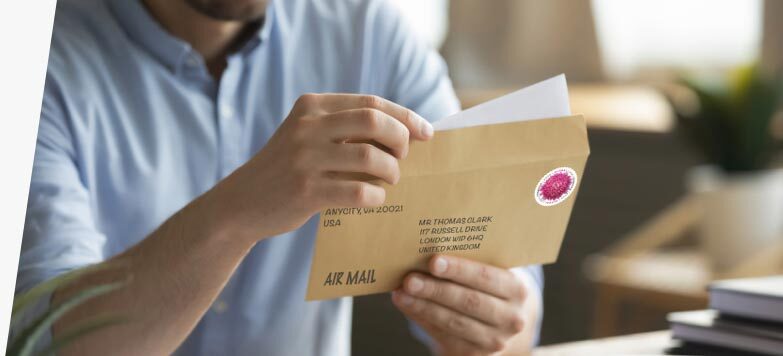
Send International Mail: Instrucciones Paso a Paso
Ampliar Todos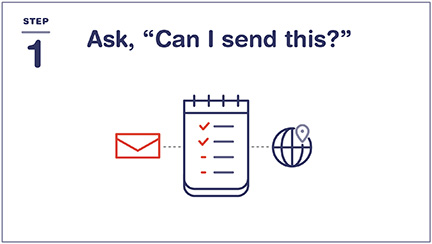
Paso 1: Ask, "Can I Send This?"
Different countries have different rules on what they’ll allow in. Look up your destination country in the Index of Countries and Localities to make sure you’re following their rules.
If you’re just sending correspondence (no trading cards, bookmarks, stickers, etc.) or nonnegotiable documents (just paper; no cash, checks, or other items that have cash value), you don’t need a customs form.
Recordatorio: You can only use First-Class Mail International® service to send correspondence (like a personal or business letter) or other nonnegotiable documents in a letter that weighs up to 3.5 oz or large envelope that weighs under 15.994 oz.
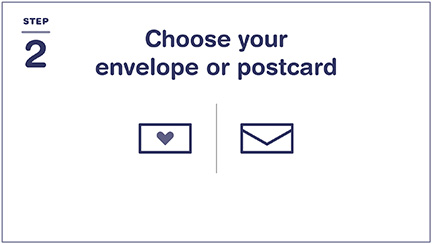
Paso 2: Choose Your Envelope or Postcard
Envelopes are for sending paper documents like letters, cards, and forms.
Las tarjetas postales son para mensajes breves que no necesita colocar en un sobre.
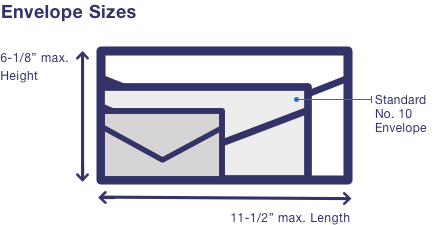
Just like U.S. letters, international letters must be rectangular and made of paper to qualify for letter prices. Letter envelopes for international mail can be 11-1/2" long x 6-1/8" high. (Un sobre N.º 10 estándar tiene 9 1/2 in de largo x 4 1/8 in de alto). Puede plegar lo que coloca en el sobre, pero debe permanecer plano, con no más de 1/4 in de espesor.
SUGERENCIA: If your letter can't fit through USPS® mail processing equipment, it’s "nonmachinable" and you’ll have to pay $0.49 more to send it. (Ver franqueo adicional en el Paso 4.) Nonmachinable items include envelopes that are lumpy or rigid, or have clasps, string, or buttons. You’ll also have to pay more if your envelopes are square or vertical (taller than they are wide).
If you want to send letter-sized correspondence without folding it, you can use a large envelope (called a 'flat"); the postage for international flats starts at $3.15. If your large envelope is nonrectangular, rigid (can't bend), or lumpy (not uniformly thick), you'll have to pay the package price.
Tarjetas postales: Standard postcards are usually made of thick paper (cardstock), are between 5-1/2" to 6" long and 3-1/2" to 4-1/4" high, and are no more than 0.016" thick. Sending a regular-sized, rectangular postcard from the U.S. to another country costs the same as sending a letter.
Requisitos de Tamaño y Peso: Tarjetas Postales y Sobres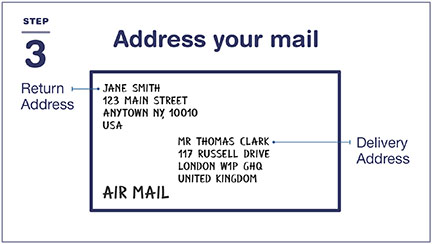
Paso 3: Destinatario de su Correo
International address formats are different for each country. You also need to write the delivery address in English (if you need to use another language, add the English translation after each line).
Sobres: Write your address (the "return" or "sender" address) in the top left corner (and put "USA" on the last line). Write the delivery address in the center (near the bottom). Put the destination country's name (in English) on the last line.
Tarjetas postales: Las tarjetas postales vienen en diferentes formatos, así que escriba la dirección de entrega en el espacio asignado (del mismo lado que escribe el mensaje y coloca la estampilla).
Imprima la dirección del remitente y la dirección de entrega de forma clara en los lugares indicados para asegurarse de que el correo se entregue a tiempo.
International Address Format Tips
- Escriba las direcciones en forma prolija en letras mayúsculas.
- Utilice una lapicera o un marcador permanente.
- Don’t use commas or periods.
Escriba la Dirección del Remitente
Write your address in the U.S. (the “return address”) in the top-left corner. Incluya lo siguiente en líneas separadas:
- Su nombre completo o el nombre de su empresa
- Número de apartamento o suite
- Dirección completa
- City, State, and ZIP+4 Code®
- USA
Escriba la Dirección de Entrega
Write the delivery address in the bottom center of the envelope.
You must write the delivery address in English, though you can include the delivery address in another language (like Russian, Greek, Arabic, Hebrew, Japanese, or Chinese), if you write the English translation after each line.
Many countries use different address formats (for example, the Postal Code might go before the city). Get specific information about other countries’ postal addresses by going to the Universal Postal Union and clicking "Postal Addressing Systems (PAS)".
Generally, include the following on separate lines:
- Nombre completo del destinatario o nombre de la empresa
- Dirección completa
- City, Subdivision (like province, state, county), and Postal Code
- País
See more on addresses in the International Mail Manual.
Address Example (United Kingdom):
MR THOMAS CLARK
117 RUSSELL DRIVE
LONDON W1P 6HQ
ROYAL MAIL DEL
NOTA: If you're sending mail to a U.S. territory, U.S. military base, or U.S. embassy in another country (APO/FPO/DPO mail), see How to Send a Letter or Postcard: Doméstico.
IMPORTANTE: When you send using First-Class Mail International, you must write "AIRMAIL/PAR AVION" on the address side of your postcard, letter, or large envelope.
When you're done addressing your envelope, put what you’re sending inside the envelope, then close and seal it.
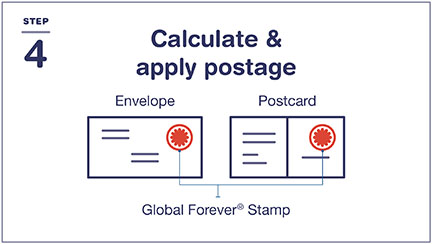
Paso 4: Calcular y Aplicar Franqueo
For just 1 $1.70 First-Class Mail International Global Forever stamp, you can send a 1 oz letter or postcard to any other country in the world.
Put stamps in the upper right corner of the envelope. (For postcards, put the stamp in the space provided near the delivery address.)
If your letter is heavier or bigger, if your postcard is large or square, or if you want to add extra services, you'll need to pay more.
Postage for international letters depends on weight, size/shape, and the price group of the country that you’re sending to. (See the Country Price Groups listing.)
Puede pesar su carta con una balanza de cocina, con una balanza postal, en un puesto de autoservicio o en el mostrador de la Post Office™.
SUGERENCIA: As a rule of thumb, you can send a 1 oz letter (4 sheets of regular printer paper and a business-sized envelope) or a postcard—to any country in the world—for 1 First-Class Mail® Global Forever stamp (currently $1.70). You can also use any other combination of stamps that adds up to $1.70.
El franqueo para un sobre (u objeto plano) grande comienza en $3.15 para 1 onza.
¿Dónde Compro el Franqueo?
- The Postal Store (Tienda postal)
Compre todas las estampillas y franqueos adicionales para sobres más grandes o pesados en línea.
- Ubicaciones de las Post Office™ (Oficinas postales)
Buy stamps at Post Offices, self-service kiosks, or at National Retailers such as grocery and drug stores.
Franqueo adicional
Compre todas las estampillas y franqueos adicionales para sobres más grandes o pesados en línea.
Buy stamps at Post Offices, self-service kiosks, or at National Retailers such as grocery and drug stores.
If your letter weighs over 1 oz, you can buy additional postage in the amount you need, up to 3.5 oz. (Also, you can mail a large envelope that weighs up to 15.994 oz, paying the rate for large envelopes [flats].):
- The price for each additional ounce will depend on the destination country's price group:
- Find the country in the Country Price Groups section of the Price List page, look in the "First-Class Mail Int'l" Price Group column, and get the price group number.
- Look in the First-Class Mail International Price List to see the fees for that price group.
- Or, just use the International Price Calculator.
- Nonmachinable letters that are lumpy, rigid, or rectangular, or that have clasps, string, or buttons will cost $0.49 more to send. You'll also have to pay more if your letters are square or vertical (taller than they are wide).
- También puede comprar estampillas de 1¢, 2¢, 3¢, 5¢ y 10¢ en The Postal Store®.
- Nota: If your large envelope (flat) is lumpy, rigid, or nonrectangular, you’ll have to pay the package price.
SUGERENCIA: Put the stamp on last; that way, if you make a mistake at any other point, you won’t waste a stamp.
Calculate International Postage
Servicios adicionales
Si desea adquirir seguro, comprobante de entrega, servicios de firma u otros servicios opcionales, tendrá que pagar un adicional. Note that not all extra services are available for all products; our International Insurance & Extra Services page has more details.
When you go to the Post Office to mail First-Class Mail International letters, some of the more common extra services that you can add include:
- Registered Mail®: Requires that the recipient sign for the mail to confirm delivery (or attempted delivery). Registered items are handled separately and securely while in the U.S.—destination country procedures may vary. The office of mailing will keep a mailing receipt, and the office of destination will keep a record of delivery.
- Acuse de Recibo: Available as an add-on when you use Registered Mail service to send a First-Class Mail International item. When you mail the item from a Post Office, a card is attached. When the item is delivered (or delivery is attempted), the card is signed and sent to you as a delivery record. (Note that some countries may not require a recipient signature.)
- Certificate of Mailing: Proof that you mailed something from a Post Office location.
A Note on Tracking: You can’t get tracking on First-Class Mail International letters. You can use Registered Mail service with Return Receipt, or use a USPS international package shipping service that offers tracking.
SUGERENCIA: If you’re sending large envelopes (flats) using Priority Mail® International, Priority Mail Express® International, or First-Class Package International Service®, you can use Click-N-Ship® service to pay for and print your own postage online.
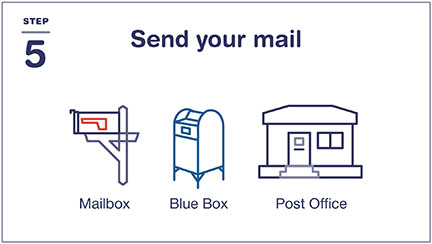
Paso 5: Envíe su Correo
Once your envelope or postcard has the correct addresses and postage, you can send it several ways, including putting it in your mailbox or dropping it in a blue collection box or at a Post Office location.
- Coloque su carta dentro de su buzón y levante la bandera (si tiene una).
- Si tiene una agrupación de buzones, colóquela en la ranura de correo saliente.
- Déjela en un buzón azul.
- Llévela a un buzón del vestíbulo de la Post Office™.
Nota Importante: Si su sobre tiene estampillas postales y pesa más de 10 oz o tiene más de 1/2 in de espesor, no puede dejarla en un buzón; tendrá que entregarla a un empleado en una Oficina Postal. See more details on What Can and Cannot be Deposited in a Collection Box®? (Also see specific guidance around dropping off mail that requires customs forms—though if you’re sending mail under 15.994 oz that’s just documents, you don’t need to do a customs form.)



